Abstract
Hepatocytes from rats that were fed ethanol chronically for 6-8 wk were found to have a modest decrease in cytosolic GSH (24%) and a marked decrease in mitochondrial GSH (65%) as compared with pair-fed controls. Incubation of hepatocytes from ethanol-fed rats for 4 h in modified Fisher's medium revealed a greater absolute and fractional GSH efflux rate than controls with maintenance of constant cellular GSH, indicating increased net GSH synthesis. Inhibition of gamma-glutamyltransferase had no effect on these results, which indicates that no degradation of GSH had occurred during these studies. Enhanced fractional efflux was also noted in the perfused livers from ethanol-fed rats. Incubation of hepatocytes in medium containing up to 50 mM ethanol had no effect on cellular GSH, accumulation of GSH in the medium, or cell viability. Thus, chronic ethanol feeding causes a modest fall in cytosolic and a marked fall in mitochondrial GSH. Fractional GSH efflux and therefore synthesis are increased under basal conditions by chronic ethanol feeding, whereas the cellular concentration of GSH drops to a lower steady state level. Incubation of hepatocytes with ethanol indicates that it has no direct, acute effect on hepatic GSH homeostasis.
Full text
PDF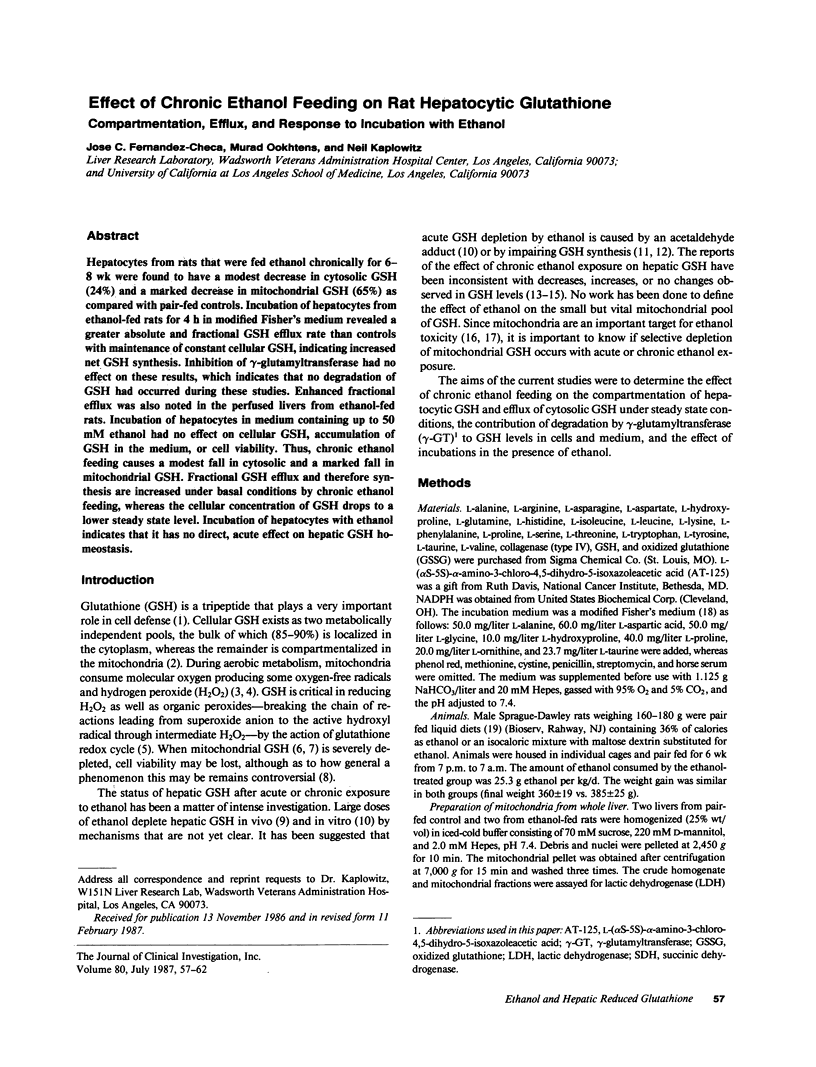

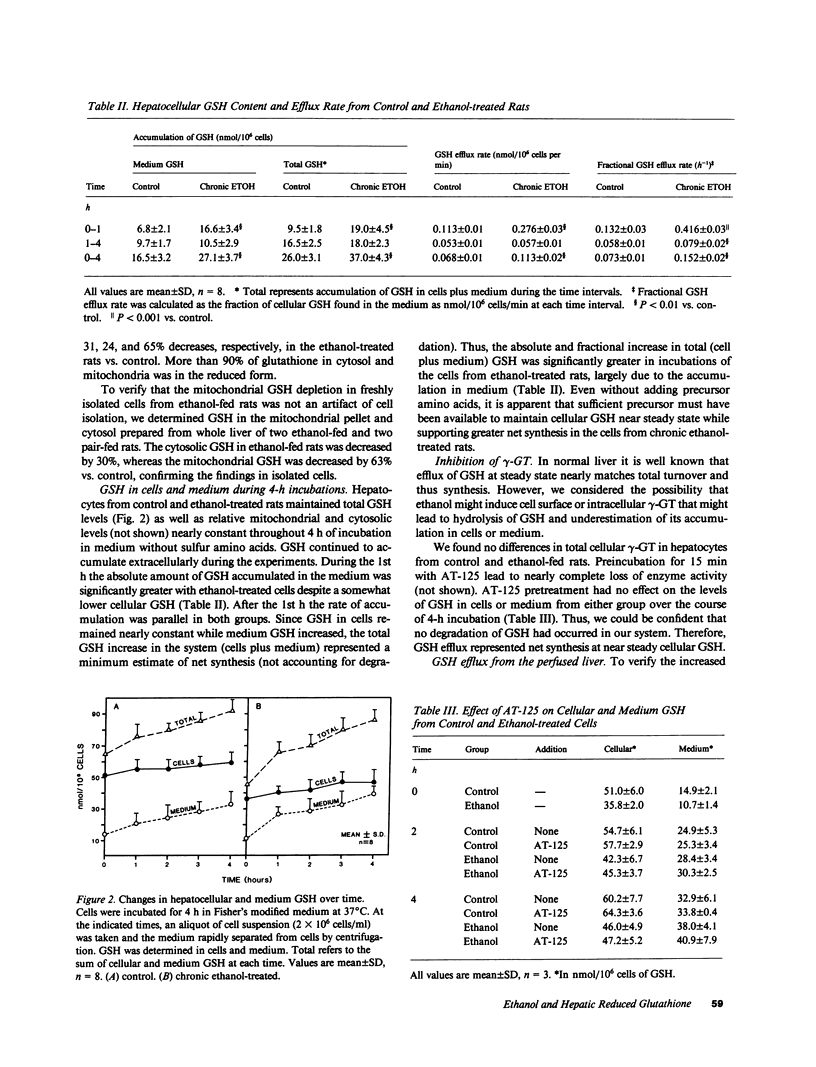
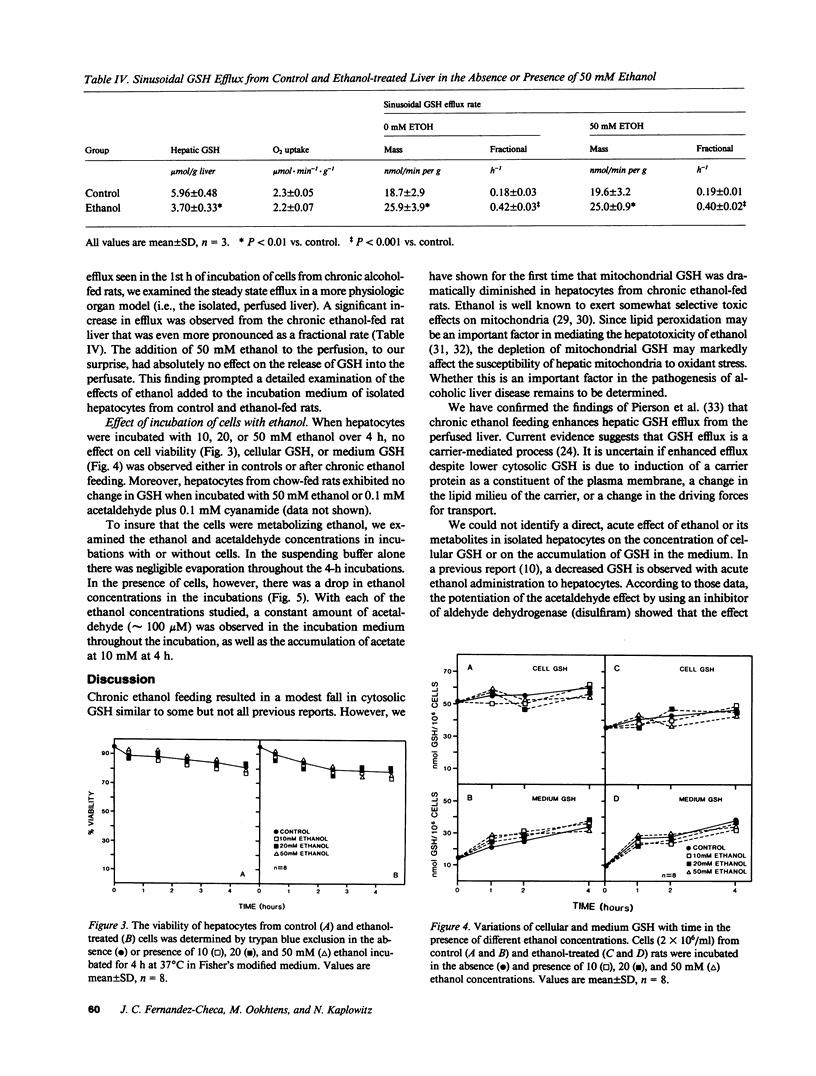
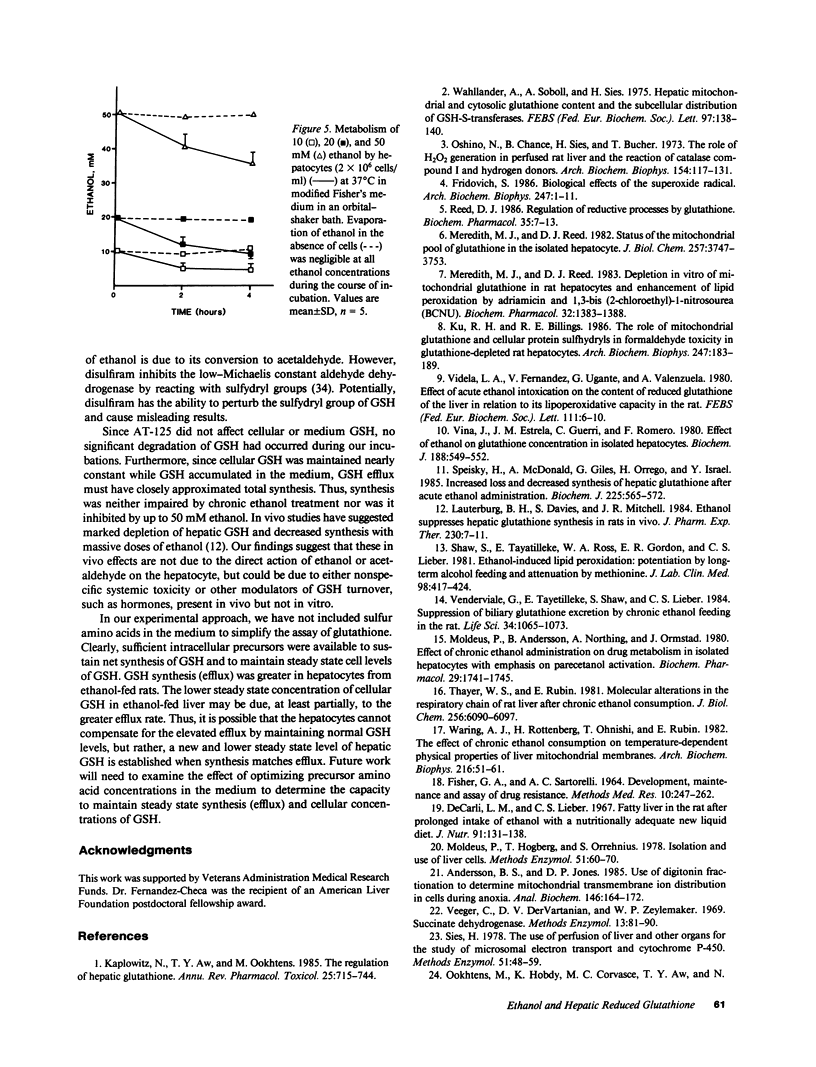
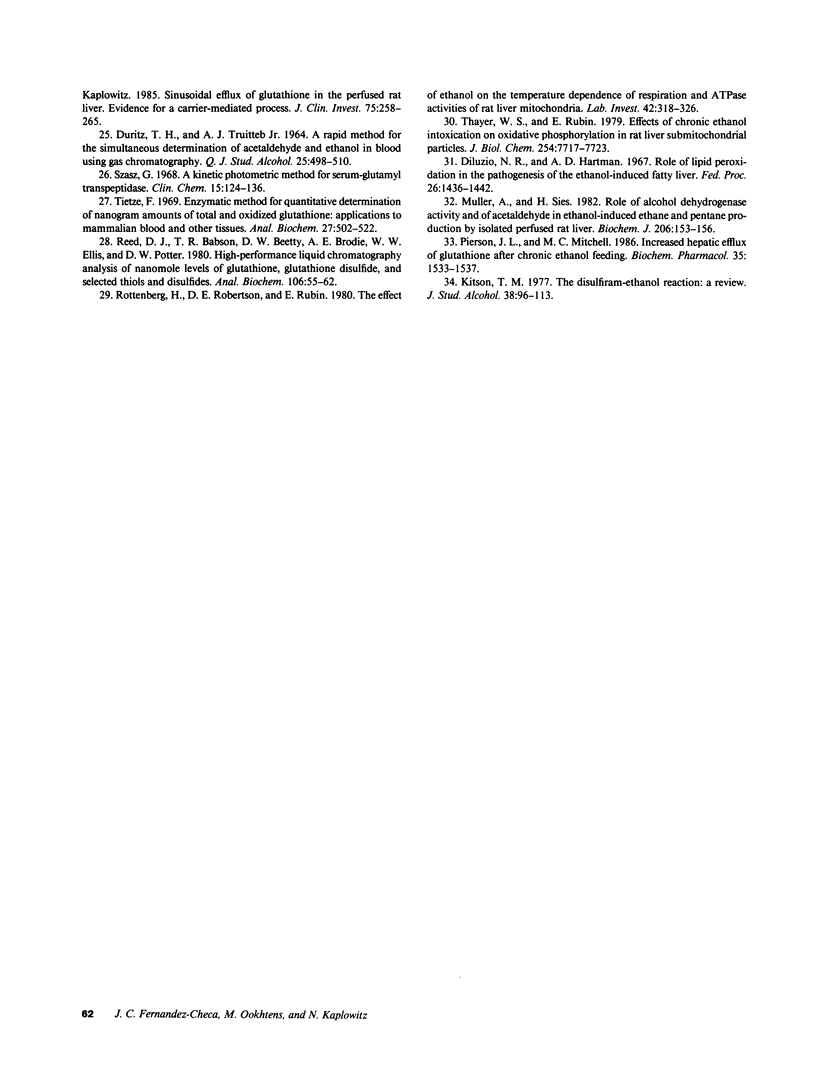
Selected References
These references are in PubMed. This may not be the complete list of references from this article.
- Andersson B. S., Jones D. P. Use of digitonin fractionation to determine mitochondrial transmembrane ion distribution in cells during anoxia. Anal Biochem. 1985 Apr;146(1):164–172. doi: 10.1016/0003-2697(85)90411-7. [DOI] [PubMed] [Google Scholar]
- DURITZ G., TRUITT E. B., Jr A RAPID METHOD FOR THE SIMULTANEOUS DETERMINATION OF ACETALDEHYDE AND ETHANOL IN BLOOD USING GAS CHROMATOGRAPHY. Q J Stud Alcohol. 1964 Sep;25:498–510. [PubMed] [Google Scholar]
- Di Luzio N. R., Hartman A. D. Role of lipid peroxidation in the pathogenesis of the ethanol-induced fatty liver. Fed Proc. 1967 Sep;26(5):1436–1442. [PubMed] [Google Scholar]
- FISCHER G. A., SARTORELLI A. C. DEVELOPMENT, MAINTENANCE AND ASSAY OF DRUG RESISTANCE. Methods Med Res. 1964;10:247–262. [PubMed] [Google Scholar]
- Fridovich I. Biological effects of the superoxide radical. Arch Biochem Biophys. 1986 May 15;247(1):1–11. doi: 10.1016/0003-9861(86)90526-6. [DOI] [PubMed] [Google Scholar]
- Kaplowitz N., Aw T. Y., Ookhtens M. The regulation of hepatic glutathione. Annu Rev Pharmacol Toxicol. 1985;25:715–744. doi: 10.1146/annurev.pa.25.040185.003435. [DOI] [PubMed] [Google Scholar]
- Kitson T. M. The disulfiram--ethanol reaction: a review. J Stud Alcohol. 1977 Jan;38(1):96–113. doi: 10.15288/jsa.1977.38.96. [DOI] [PubMed] [Google Scholar]
- Ku R. H., Billings R. E. The role of mitochondrial glutathione and cellular protein sulfhydryls in formaldehyde toxicity in glutathione-depleted rat hepatocytes. Arch Biochem Biophys. 1986 May 15;247(1):183–189. doi: 10.1016/0003-9861(86)90547-3. [DOI] [PubMed] [Google Scholar]
- Lauterburg B. H., Davies S., Mitchell J. R. Ethanol suppresses hepatic glutathione synthesis in rats in vivo. J Pharmacol Exp Ther. 1984 Jul;230(1):7–11. [PubMed] [Google Scholar]
- Meredith M. J., Reed D. J. Depletion in vitro of mitochondrial glutathione in rat hepatocytes and enhancement of lipid peroxidation by adriamycin and 1,3-bis(2-chloroethyl)-1-nitrosourea (BCNU). Biochem Pharmacol. 1983 Apr 15;32(8):1383–1388. doi: 10.1016/0006-2952(83)90451-3. [DOI] [PubMed] [Google Scholar]
- Meredith M. J., Reed D. J. Status of the mitochondrial pool of glutathione in the isolated hepatocyte. J Biol Chem. 1982 Apr 10;257(7):3747–3753. [PubMed] [Google Scholar]
- Moldéus P., Andersson B., Norling A., Ormstad K. Effect of chronic ethanol administration on drug metabolism in isolated hepatocytes with emphasis on paracetamol activation. Biochem Pharmacol. 1980 Jun 15;29(12):1741–1745. doi: 10.1016/0006-2952(80)90134-3. [DOI] [PubMed] [Google Scholar]
- Moldéus P., Högberg J., Orrenius S. Isolation and use of liver cells. Methods Enzymol. 1978;52:60–71. doi: 10.1016/s0076-6879(78)52006-5. [DOI] [PubMed] [Google Scholar]
- Müller A., Sies H. Role of alcohol dehydrogenase activity and the acetaldehyde in ethanol- induced ethane and pentane production by isolated perfused rat liver. Biochem J. 1982 Jul 15;206(1):153–156. doi: 10.1042/bj2060153. [DOI] [PMC free article] [PubMed] [Google Scholar]
- Ookhtens M., Hobdy K., Corvasce M. C., Aw T. Y., Kaplowitz N. Sinusoidal efflux of glutathione in the perfused rat liver. Evidence for a carrier-mediated process. J Clin Invest. 1985 Jan;75(1):258–265. doi: 10.1172/JCI111682. [DOI] [PMC free article] [PubMed] [Google Scholar]
- Oshino N., Chance B., Sies H., Bücher T. The role of H 2 O 2 generation in perfused rat liver and the reaction of catalase compound I and hydrogen donors. Arch Biochem Biophys. 1973 Jan;154(1):117–131. doi: 10.1016/0003-9861(73)90040-4. [DOI] [PubMed] [Google Scholar]
- Pierson J. L., Mitchell M. C. Increased hepatic efflux of glutathione after chronic ethanol feeding. Biochem Pharmacol. 1986 May 1;35(9):1533–1537. doi: 10.1016/0006-2952(86)90121-8. [DOI] [PubMed] [Google Scholar]
- Reed D. J., Babson J. R., Beatty P. W., Brodie A. E., Ellis W. W., Potter D. W. High-performance liquid chromatography analysis of nanomole levels of glutathione, glutathione disulfide, and related thiols and disulfides. Anal Biochem. 1980 Jul 15;106(1):55–62. doi: 10.1016/0003-2697(80)90118-9. [DOI] [PubMed] [Google Scholar]
- Reed D. J. Regulation of reductive processes by glutathione. Biochem Pharmacol. 1986 Jan 1;35(1):7–13. doi: 10.1016/0006-2952(86)90545-9. [DOI] [PubMed] [Google Scholar]
- Rottenberg H., Robertson D. E., Rubin E. The effect of ethanol on the temperature dependence of respiration and ATPase activities of rat liver mitochondria. Lab Invest. 1980 Mar;42(3):318–326. [PubMed] [Google Scholar]
- Shaw S., Jayatilleke E., Ross W. A., Gordon E. R., Leiber C. S. Ethanol-induced lipid peroxidation: potentiation by long-term alcohol feeding and attenuation by methionine. J Lab Clin Med. 1981 Sep;98(3):417–424. [PubMed] [Google Scholar]
- Sies H. The use of perfusion of liver and other organs for the study of microsomal electron-transport and cytochrome P-450 systems. Methods Enzymol. 1978;52:48–59. doi: 10.1016/s0076-6879(78)52005-3. [DOI] [PubMed] [Google Scholar]
- Speisky H., MacDonald A., Giles G., Orrego H., Israel Y. Increased loss and decreased synthesis of hepatic glutathione after acute ethanol administration. Turnover studies. Biochem J. 1985 Feb 1;225(3):565–572. doi: 10.1042/bj2250565. [DOI] [PMC free article] [PubMed] [Google Scholar]
- Szasz G. A kinetic photometric method for serum gamma-glutamyl transpeptidase. Clin Chem. 1969 Feb;15(2):124–136. [PubMed] [Google Scholar]
- Thayer W. S., Rubin E. Effects of chronic ethanol intoxication on oxidative phosphorylation in rat liver submitochondrial particles. J Biol Chem. 1979 Aug 25;254(16):7717–7723. [PubMed] [Google Scholar]
- Thayer W. S., Rubin E. Molecular alterations in the respiratory chain of rat liver after chronic ethanol consumption. J Biol Chem. 1981 Jun 25;256(12):6090–6097. [PubMed] [Google Scholar]
- Tietze F. Enzymic method for quantitative determination of nanogram amounts of total and oxidized glutathione: applications to mammalian blood and other tissues. Anal Biochem. 1969 Mar;27(3):502–522. doi: 10.1016/0003-2697(69)90064-5. [DOI] [PubMed] [Google Scholar]
- Vendemiale G., Jayatilleke E., Shaw S., Lieber C. S. Depression of biliary glutathione excretion by chronic ethanol feeding in the rat. Life Sci. 1984 Mar 12;34(11):1065–1073. doi: 10.1016/0024-3205(84)90020-1. [DOI] [PubMed] [Google Scholar]
- Videla L. A., Fernandez V., Ugarte G., Valenzuela A. Effect of acute ethanol intoxication on the content of reduced glutathione of the liver in relation to its lipoperoxidative capacity in the rat. FEBS Lett. 1980 Feb 25;111(1):6–10. doi: 10.1016/0014-5793(80)80749-6. [DOI] [PubMed] [Google Scholar]
- Viña J., Estrela J. M., Guerri C., Romero F. J. Effect of ethanol on glutathione concentration in isolated hepatocytes. Biochem J. 1980 May 15;188(2):549–552. doi: 10.1042/bj1880549. [DOI] [PMC free article] [PubMed] [Google Scholar]
- Wahlländer A., Soboll S., Sies H., Linke I., Müller M. Hepatic mitochondrial and cytosolic glutathione content and the subcellular distribution of GSH-S-transferases. FEBS Lett. 1979 Jan 1;97(1):138–140. doi: 10.1016/0014-5793(79)80069-1. [DOI] [PubMed] [Google Scholar]
- Waring A. J., Rottenberg H., Ohnishi T., Rubin E. The effect of chronic ethanol consumption on temperature-dependent physical properties of liver mitochondrial membranes. Arch Biochem Biophys. 1982 Jun;216(1):51–61. doi: 10.1016/0003-9861(82)90187-4. [DOI] [PubMed] [Google Scholar]


